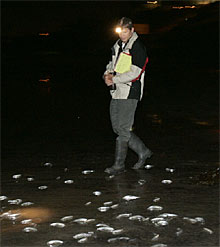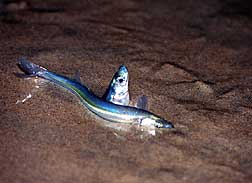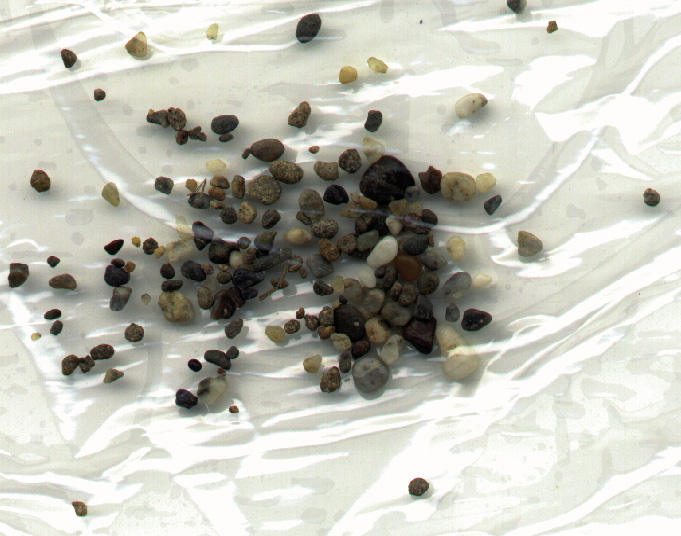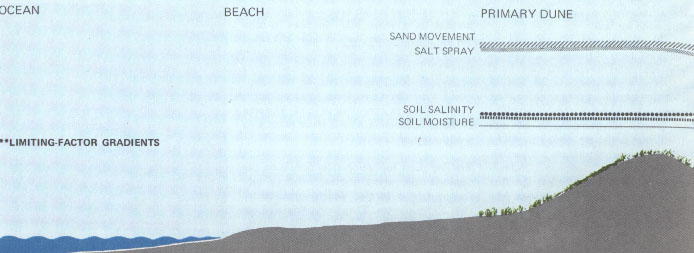Seychelles, beaches in the tropical Indian Ocean, JVS; 1989.
Sea Beach
grain size | terms to know | related ideas | Setting | Physical | Biological | Social | profile of the dunes | Lesson | Sites
Navigating the site:
The Sandy Shore
The Grunion are running they say tonight, the grunion are running!
While it almost is too true to believe its actually a high tide experience in Santa Barbara, and Malibu, or other southern California sandy beaches, because these sardine like fish lay their eggs in the sand at or near the high tide during the summer. I will never forget the feeling of thousands, even hundreds of thousands of squirming, slimy and ever moving creatures seething in unison to lay their eggs as I walked along the moonlit beach, surf pounding, air crisp from the day's fog and the cold current pressing us all against the gently sloping beaches.
There during a summer's night on a beach in Malibu squishing about under the rolling tongue of the surf as it advanced and retreated, I felt more than the teeming life of the fish of this shore under my feet. I felt more than the ocean heave beneath my bare legs and I felt more than the spawning fish wriggling into and out of the sand between the waves between my cold toes. I was moved in my naiveté to recall that the sea will claim us us all in the end and it will take you places only if you learn how to live with its immensity in the smallness of your heart.
JVS, free writing, 04.
Typical beach of a barrier island:
Transect of a typical barrier island littoral of the beach.
Fore shore [nearest the ocean] versus Back shore [farther inland].
berm -- single most important feature of the shore, dividing line.
vegetation line -- indicator of storm, surge, and spring tide
mean high tide -- a legal demarcation with respect to state ownership
mean low tide -- biological demarcation of the sublittoral zone
intertidal zonation -- divisions of the shore into "life zones."
What some animals do on the beach is "censored."
longshore currents shape the beach
What features comprise any site?
Perhaps it is the excitement, the allure, the expanse onto which the mysteries spill that make the beach --that "rim of sand"-- so seductive to our imaginations that we will do anything for a beach experience?
By that I mean that in the last century the coastal states, through the Federal treasury have spent over four billion dollars --$4 billion: $4,000.000.000-- in putting sand back where we think it belongs.
As opposed to where the longshore current, rivers and tides place the sandy sediment, marine engineers, based largely on the Dutch experiences and wartime necessities, have become quite adept at putting eroded sands back onto the remaining beaches. This has three fundamental facets you must understand:
1. the process of re-engineering a sandy habitat is called "beach renourishment" by the Army Corps of Engineers.
2. the renourishment of a beach involves the transport of deep water sand of finer grain sizes onto the existing --or remaining sandy rim-- where sand grain sizes are usually larger.
3. the impact of beach renourishment on ghost shrimp and ghost crabs, worms, shorebirds and even turtles is significant in that the grain sizes select for certain species and against existing species who dwell in the intertidal zone.
Beach erosion and renourishment's costs essay
Physical properties of sand
rules | conclusions | law
The material's grain size is proportional to the amount of wave, current or tidal energy required to move the suspended sediment from one place to another.
The measure of suspended sediment (blocks light) in the water is called turbidity.
Axiom 2:
The material has a diameter which determines it's type:
type distinguished by particle name size range
in millimeters = .039"
- clay
< .004
Shale Mud
- silt ~
Siltstone Mud
- sand ~
Sandstone
- granule ~
smooth angular Conglomerate Breccia
- pebble ~
4.00 - 64.00
- cobble ~
- boulder ~
artifacts Geological formations Stanley Chernicoff, Geology
Axiom 3:
The movement of sediment along the shore stops when the force of the current created by waves, wind, tides or littoral drift encounters grains of a size that the velocity of the water mass is unable to transport.
Therefore, sediment sizes are sorted by water as it moves and can be indicators of the force of the water on any shore or littoral.
Corollary a:
The resulting conditions of shoreline habitats to which living creatures must adapt, is to a large extent determined by the substrate.
Corollary b:
Any substrate that is not rock, or bedrock, is made up of a particular mix of sediment determined largely by the wind or water conditions existing when the material was laid-down. Subsequent weathering, or exposure to climate over time affects what we see on the land.
Different deposits, based on aggregate grain sizes have specific ranges of capacity for supporting the mass of anything dwelling in or on the substrate.
sedimentation -- the process by which silt, clay, mud, sand or gravel moves from one place (habitat) to another.
| Legal terms | accretion | reliction |
|
Common
terms |
deposition | erosion |
|
meaning |
sediment accumulates | sediment disappears |
Biological communities along the sand
Creatures must adjust to the transient character of sandy shores, or migrate. These are indicator species of seaside conditions:
- Semipalmated sandpiper
- razor clams
- ghost shrimps
- sand dollars
- Emerita, mole crabs
- coquina clams
- amphipods {beach hoppers} (pp. 161-162)
- sargassum weed
- green algae
- sea grass beds:
- phylospadix
- turtle grass
- widgeon grass
- manatee grass
- shoal grass
- ponderous ark shells
- moon snails
- whelks
- shipworms
- ascidians
- marine (toredo) worms
- blood worms
- urechis (burrowing worm) Pacific shores
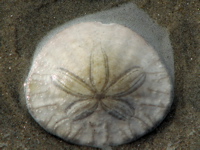
overview of The Edge of the Sea.
Primary dune
Transect of a typical shore.
sublittoral | intertidal | splash zone | fore shore | berm | back shore | fore dune |
halimeda ........ worms ......... mole crabs ........ ghost crabs ...... turtle nesting areas .....sea oats ......
whelks & conchs ------cocina -&- razor clams --- shore birds feeding ---amphipods---rocket, ambrosia
Let us accept the proposition that nature is process, that it is interacting, that it responds to laws, representing values and opportunities for human use with certain limitations and even prohibitions to certain of these.”
page 7.
“In their long dialogue with the sea the Dutch have learned that it cannot be stopped but merely directed or tempered, and so they have always selected flexible construction.”
“Perhaps the most reasonable approach would be to investigate the tolerance or intolerance of the various environments to human use in general and to some particular uses.”
page 13
The above material is from Ian Mcharg's chapter on Sea & Survival from Design with Nature.
"The peninsula stands farther out to sea than any other portion of the United States; it is the outermost of outer shores. Thundering against the cliff, the ocean here encounters the last defiant bulwark of two worlds."
Henry Beston, The Outermost House, pp. 3-4. 1949.
"The bulk of the seashore sand is derived from the weathering and decay of rocks, transported from their place of origin to the sea by rains and the rivers. The unhurried processes of erosion, in the freighting seaward, in the interruptions and resumptions of that journey,.... In the mountains the slow decay and the disintegration of rocks proceed, and the stream of sediments grows --suddenly and dramatically by rockslides--...."
R. Carson, pp. 126-127.
This page was just renewed on
•11/14/2008•

.gif)
